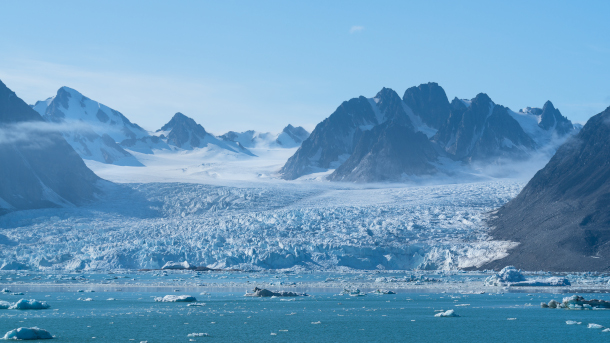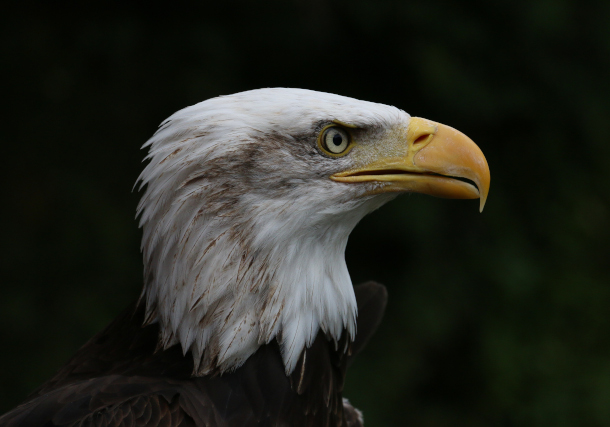Beyond the Headlines
Air Date: Week of June 30, 2023

The Arctic Ocean is becoming warmer and saltier, which is more akin to the Atlantic Ocean, in a process known as “Atlantification”. (Photo: Alex Berger, Flickr, CC BY-NC 2.0)
This week, Peter Dykstra joins Host Aynsley O’Neill to share news of the “Atlantification” of the Arctic Ocean, as species more accustomed to warmer waters find safe harbor in the warming Arctic. They also cover the $10 billion settlement deal with 3M over contamination from the PFAS chemicals it manufactures. And in history, a look back to the delisting of the bald eagle, which had recovered following a few decades on the endangered species list.
Transcript
BELTRAN: It’s Living on Earth, I’m Paloma Beltran
O’NEILL: And I’m Aynsley O’Neill.
It's time now for a look beyond the headlines with Peter Dykstra. He's Living on Earth's contributor and he joins us from Atlanta, Georgia. Hey there, Peter, what do you have for us this week?
DYKSTRA: Hi, Aynsley. I read this headline and I think I read it a little bit wrong. It's from Hakai Magazine, which is a wonderful publication for long reports on our relationship with the oceans. And the headline was "The Atlantification of the Arctic Ocean is Underway." And I thought, holy cow, the Arctic Ocean is getting like Atlanta? Just think of the traffic.
O'NEILL: Well, if it isn't about Atlanta, then what is it about, Peter?
DYKSTRA: The Atlantic Ocean. The Arctic Ocean is becoming more like the Atlantic, based on studies by German researchers. Also backed up by Norwegian researchers, who saw the same thing happening in the Russian Arctic. There's a tiny fish called capelin, and capelin are food for larger sea life, ranging from big fish to seals and whales. But they're also a signature species for the Atlantic and parts of the Pacific, not the Arctic. And if they show up in the Arctic as they have off the coast of Greenland, then it means they could be crowding out native Arctic fish species.
O'NEILL: Well, I suppose that's the real question. If the Atlantic species are swimming on up to the Arctic, where are the Arctic species gonna go?
DYKSTRA: We don't know where they're going to go. We know that they can't move to the north. Because there is nowhere farther north. There are other species, not just the capelin, but a charmingly named animal called the cockeyed squid that are also moving northward. And over in the Barents Sea, north of Russia, there seems to be similar things going on with Atlantic Ocean based fish, including the capelin, showing up where only Arctic species showed up before.
O'NEILL: All right, Peter, what else do you have for us this week?

3M has reached a settlement to pay $10.3 billion over 13 years to public utilities that have detected PFAS in their drinking water supplies. (Photo: Gerard Stolk, Flickr, CC BY-NC 2.0)
DYKSTRA: We talked recently about DuPont and two of its spin off companies agreeing to a $1.19 billion settlement to help resolve claims that the chemicals PFAS had polluted water supplies in American towns, cities and counties. Now comes word of a bigger settlement. 3M also manufactures PFAS chemicals. Those are the "forever chemicals," so named because for all intents and purposes they never go away once they enter the system. They're linked to liver damage, cancers and so many other human maladies. But 3M has now agreed to a settlement of $10.3 billion for its problems with manufacturing PFAS. It all started with a suit from the city of Stuart, Florida, who claimed that its drinking water wells were actually contaminated by those PFAS chemicals in firefighting foam that ironically, was sprayed by the city of Stuart itself on itself.
O'NEILL: $10.3 billion, that's quite a deal. So, if 3M has reached that settlement, what's going to happen next?
DYKSTRA: The judge still has to approve the settlement. But bear in mind a couple of other things. Experts say that 3M may face as much as $30 billion in claims once they're all added up. For its matter, 3M says it will quit the PFAS business by the year 2025, which to me sounds a little bit like an admission that there's something wrong with these chemicals. However, in the settlements with DuPont and with 3M, the manufacturers admit they did nothing wrong.
O'NEILL: Hmm. Curiouser and curiouser. But Peter, I believe it is now time to take a look through those history books. What do you have for us from there?

Bald eagles were first put under federal protection with the Bald Eagle Protection Act in 1940, but populations continued to decline. In 2007, the species had rebounded enough from its low numbers in the low 48 states that it was removed from the Endangered Species list. (Photo: Chris Parker, Flickr, CC BY-ND 2.0)
DYKSTRA: June 28, 2007. George W. Bush's Interior Secretary Dirk Kempthorne removed the bald eagle from the endangered species list. It had been on there since the creation of the list back in the early 1970s. It had taken a long, long time to get the eagle off the list in the lower 48. It was never endangered in Alaska. But the bald eagles' decline and many other bird species were blamed on the pesticide DDT, which was also banned in the early 70s. Birds as big as bald eagles and pelicans, birds as small as hummingbirds, had their eggshells thinned by this pesticide, and that caused a plummeting of populations throughout the country. It took from the early 70s until 2007 to sound the all-clear for bald eagles, but it is one victory and one sign that environmental regulation can work and work very well.
O'NEILL: With the June 28th anniversary, sounds like those bald eagles made it off the list just in time for Independence Day.
DYKSTRA: That's right. They're probably hiring out for July 4 right now.
O'NEILL: Well, thanks, Peter. Peter Dykstra is a contributor to Living on Earth and we'll talk to you again real soon.
DYKSTRA: All right. Aynsley. Thanks a lot. Talk to you soon.
O'NEILL: And there's more on the stories on the Living on Earth website. That's LOE.org.
Links
Hakai Magazine | “The Atlantification of the Arctic Ocean Is Underway”
The New York Times | “3M Reaches $10.3 Billion Settlement in ‘Forever Chemicals’ Suits”
Learn more about the bald eagle and the history of its protection
Living on Earth wants to hear from you!
Living on Earth
62 Calef Highway, Suite 212
Lee, NH 03861
Telephone: 617-287-4121
E-mail: comments@loe.org
Newsletter [Click here]
Donate to Living on Earth!
Living on Earth is an independent media program and relies entirely on contributions from listeners and institutions supporting public service. Please donate now to preserve an independent environmental voice.
NewsletterLiving on Earth offers a weekly delivery of the show's rundown to your mailbox. Sign up for our newsletter today!
 Sailors For The Sea: Be the change you want to sea.
Sailors For The Sea: Be the change you want to sea.
 The Grantham Foundation for the Protection of the Environment: Committed to protecting and improving the health of the global environment.
The Grantham Foundation for the Protection of the Environment: Committed to protecting and improving the health of the global environment.
 Contribute to Living on Earth and receive, as our gift to you, an archival print of one of Mark Seth Lender's extraordinary wildlife photographs. Follow the link to see Mark's current collection of photographs.
Contribute to Living on Earth and receive, as our gift to you, an archival print of one of Mark Seth Lender's extraordinary wildlife photographs. Follow the link to see Mark's current collection of photographs.
 Buy a signed copy of Mark Seth Lender's book Smeagull the Seagull & support Living on Earth
Buy a signed copy of Mark Seth Lender's book Smeagull the Seagull & support Living on Earth

